System Navigation Guide: Difference between revisions
Lwinchester (talk | contribs) |
(Formatting changes) |
||
| Line 1: | Line 1: | ||
<noinclude> | |||
=='''INTRODUCTION'''== | =='''INTRODUCTION'''== | ||
</noinclude> | |||
The purpose of this document is to provide the user with knowledge of how to navigate throughout the ''CALIDUS'' system. This document includes basic navigation of the screen, functionality of Icons and screen layouts. | |||
=='''OUTLINE'''== | =='''OUTLINE'''== | ||
The main menu screen is the first screen displayed when the user has logged into the system. The toolbars around the perimeter of the screen are generic throughout the system and provide the user with various options to update, insert, query and display information. | The main menu screen is the first screen displayed when the user has logged into the system. The toolbars around the perimeter of the screen are generic throughout the system and provide the user with various options to update, insert, query and display information. | ||
<center>[[Image:NAV-001a.PNG]]</center> | <center>[[Image:NAV-001a.PNG]]</center> | ||
==='''Function toolbar'''=== | |||
The purpose of the function toolbar is to allow the user to query, insert, delete and update information. The main applications used are shown as icons on the formatting toolbar. | The purpose of the function toolbar is to allow the user to query, insert, delete and update information. The main applications used are shown as icons on the formatting toolbar. | ||
| Line 23: | Line 22: | ||
*''Action'' | |||
** ''Save'' - saves changed data (see below for important information on saving) | |||
* Save | ** ''Clear All'' - clears all existing data | ||
* Clear All | ** ''Print'' - prints the screen | ||
* Print | ** ''Exit'' - exits the screen (however use the exit icon - see below) | ||
* Exit | *''Edit'' | ||
** ''Cut'' - cuts selected information to be moved elsewhere* | |||
** ''Copy'' - makes a copy of selected information* | |||
** ''Paste'' - pastes either the cut or copied information to the selected new location* | |||
* Cut | ** ''Edit'' - find and replace function for text | ||
* Copy | ** ''Display list'' - produces a list of values for the field that can be selected for the field | ||
* Paste | *''Query'' | ||
* Edit | ** ''Enter'' - used to find existing data using specific parameters | ||
* Display list | ** ''Execute'' - asks the system to find data within selected parameters | ||
** ''Cancel'' - cancels any query that was set up | |||
** ''Last criteria'' - retrieves last query | |||
** ''Count hits'' - displays quantity of records to search | |||
* | ** ''Fetch next set'' - retrieves next set of data | ||
* | *''Block'' | ||
* | ** ''Previous'' - moves cursor to previous block of data | ||
* Last criteria | ** ''Next'' - moves cursor to next block of data | ||
* Count hits | ** ''Clear'' - clears information in the block of data the cursor is in | ||
* Fetch next set | *''Record'' | ||
** ''Previous'' - displays previous record | |||
** ''Next'' - displays next record | |||
** ''Page up'' - moves scroll bar up | |||
* Previous | ** ''Page down'' - moves scroll bar down | ||
* Next | ** ''First'' - displays first record | ||
* Clear | ** ''Last'' - display last record | ||
** ''Insert'' - clears data for new record to be inserted | |||
** ''Remove'' - deletes data permanently | |||
** ''Duplicate'' - duplicate previous record data in next record for updating purposes | |||
* Previous | ** ''Clear'' - clear the record | ||
* Next - displays next record | *''Field'' | ||
* Page up | ** ''Previous'' - moves to previous field | ||
* Page down | ** ''Next'' - moves to next field | ||
* First | ** ''Clear'' - clears the selected field | ||
* Last | ** ''Duplicate'' - duplicates previous field data in next detail line | ||
* Insert | *''Help'' | ||
* Remove | ** ''Screen Help'' - prompts a help page for the screen | ||
* Duplicate | ** ''Contents and Index'' - N/A | ||
* Clear | ** ''Properties'' - displays the properties of the selected field | ||
** ''Keys'' - lists the functions keys to use instead of a mouse | |||
** ''Display error'' - display error details on the information bar | |||
** ''Display common'' - displays common details about the user and system setting | |||
* Previous | ** ''About fulfillmentSCE'' - web page | ||
* Next | |||
* Clear | |||
* Duplicate | |||
* Screen Help | |||
* Contents and Index | |||
* Properties | |||
* Keys | |||
* Display error | |||
* Display common | |||
* About fulfillmentSCE | |||
==='''Format Toolbar'''=== | ==='''Format Toolbar'''=== | ||
The formatting toolbar is made up of the most regular functions used in navigating through the system. Icon buttons are displayed for quick access, all the functions are as detailed in the previous section. | |||
The formatting toolbar is made up of the most regular functions used in navigating through the system. Icon buttons are displayed for quick access, all the functions are detailed in section | |||
<center>[[Image:NAV-004.PNG]]</center> | <center>[[Image:NAV-004.PNG]]</center> | ||
'''From left to right:''' | |||
* '''Save''' | |||
* '''Print''' | |||
* '''Cut''' * | |||
* '''Copy''' * | |||
* '''Paste''' * | |||
* '''List of Values (LOV)''' | |||
* '''Enter a query''' | |||
* '''Execute a query''' | |||
* '''Cancel a query''' | |||
* '''First record''' | |||
* '''Previous page''' | |||
* '''Previous record''' | |||
* '''Next record''' | |||
* '''Next page''' | |||
* '''Last page''' | |||
* '''Insert''' | |||
* '''Remove''' | |||
* '''Clear''' | |||
* '''Help''' | |||
* '''Exit''' | |||
{{Note}} Items marked with an asterisk (*) are mainly used in Notepad screens. | |||
* | |||
===='''TO SAVE CHANGES/AMENDMENTS'''==== | ===='''TO SAVE CHANGES/AMENDMENTS'''==== | ||
{{Note}} '''To ensure that any change to data input is saved, even to a single field, you must move out of the last field that you have changed before you exit the screen. If you do not then the system will not recognise the change, even if you hit save.''' | |||
You can move out of the last changed field by either using the enter key, the tab key or by using your mouse to click onto another field. | |||
==='''Title Bar'''=== | ==='''Title Bar'''=== | ||
The purpose of the title bar is to tell the user the system parameters that they are working within. | |||
<center>[[image:NAV-007.PNG]]</center> | <center>[[image:NAV-007.PNG]]</center> | ||
| Line 141: | Line 115: | ||
==='''Navigation Toolbar'''=== | ==='''Navigation Toolbar'''=== | ||
The purpose of this toolbar is to help the user navigate through the menu tree options. | The purpose of this toolbar is to help the user navigate through the menu tree options. | ||
<center>[[image:NAV-008.PNG]]</center> | <center>[[image:NAV-008.PNG]]</center> | ||
===='''Screen Locator'''==== | ===='''Screen Locator'''==== | ||
The purpose of the screen locator is to find a screen if the user is unsure about where is it located in the menu tree. | The purpose of the screen locator is to find a screen if the user is unsure about where is it located in the menu tree. | ||
When the user clicks on the locator button a screen appears which enables the user to enter either the screen number or the screen title. The system searches for the screen when the | When the user clicks on the locator button a screen appears which enables the user to enter either the screen number or the screen title. The system searches for the screen when the 'execute query' button is pressed and displays the screen details in the information bar underneath. When the user clicks on the detail line they are taken into the screen. It should be noted, however, that the Screen Locator tool will only 'find' screens that are included in the menu trees. It will not 'find' screens that are called from within another screen. | ||
| Line 166: | Line 131: | ||
===='''Messages'''==== | ===='''Messages'''==== | ||
The purpose of the message icon is functionally the same as normal e-mail; the screen displays messages received and clicking on the details line or clicking the details button will open up the message. It is not an e-mail function. It will only send mail to other ''CALIDUS'' system users who are included in a valid e-mail list. | |||
The purpose of the message icon is functionally the same as normal e-mail; the screen displays messages received and clicking on the details line or clicking the details button will open up the message. It is not an e-mail function. It will only send mail to other | |||
The filter is used to specify what the user wants to do; | The filter is used to specify what the user wants to do; | ||
* To compile a message, select new from the filter or click on the new button | * To compile a message, select new from the filter or click on the new button | ||
* To read received mail, select received from the filter (a message is received when the message button is yellow instead of white). | * To read received mail, select received from the filter (a message is received when the message button is yellow instead of white). | ||
* To view deleted messages, select deleted from the filter | * To view deleted messages, select deleted from the filter | ||
* To check if a message has been read, select outgoing from the filter | * To check if a message has been read, select outgoing from the filter | ||
<center>[[image:NAV-010.PNG]]</center> | <center>[[image:NAV-010.PNG]]</center> | ||
==='''Tree Structures'''=== | ==='''Tree Structures'''=== | ||
The purpose of the main menu screen is to allow the user access to the required screen. The tree menu structure is designed to allow the user to access the screens logically and quickly. The meuns are configurable and can be customised as required. See [[Menu Maintenance]] for more details. | |||
The purpose of the main menu screen is to allow the user access to the required screen. The tree menu structure | |||
All information is stored in yellow file folders to the left of the screen, if the folder has a plus sign to the left of it, then there are more folders associated with it. | All information is stored in yellow file folders to the left of the screen, if the folder has a plus sign to the left of it, then there are more folders associated with it. | ||
| Line 200: | Line 156: | ||
<center>[[image:NAV-011.PNG]]</center> | <center>[[image:NAV-011.PNG]]</center> | ||
==='''Information Bar'''=== | ==='''Information Bar'''=== | ||
The purpose of the information bar is to provide details to the user of what the status of the screen is, i.e. executing a query, loading a new screen, or, what functions are available for the selected field. | The purpose of the information bar is to provide details to the user of what the status of the screen is, i.e. executing a query, loading a new screen, or, what functions are available for the selected field. | ||
| Line 212: | Line 165: | ||
<center>[[image:NAV-012.PNG]]</center> | <center>[[image:NAV-012.PNG]]</center> | ||
==='''Querying Records'''=== | ==='''Querying Records'''=== | ||
The purpose of querying records is to search, locate and display information quickly rather than paging through information. | The purpose of querying records is to search, locate and display information quickly rather than paging through information. | ||
To enter a query the user clicks on the | To enter a query the user clicks on the 'enter query' button on the formatting toolbar. The user will know that they are in 'enter query' mode when the title bar changes colour and the information bar will have a query message displayed on it. | ||
The user then enters the information they wish to query i.e. a booking reference and clicks on the | The user then enters the information they wish to query i.e. a booking reference and clicks on the 'execute query' button on the formatting toolbar, the system will then display the relevant record and the title bar and information bar will return back to normal. | ||
The cancel query button will clear any query information that is on the screen to allow the user to enter new details. | The cancel query button will clear any query information that is on the screen to allow the user to enter new details. | ||
| Line 230: | Line 181: | ||
==='''List of Values (LOV)'''=== | ==='''List of Values (LOV)'''=== | ||
The purpose of a list of values is to provide the user with associated information attached to a specific field. The mandatory or main information fields will usually have a LOV attached to it. This is shown in the information bar at the bottom of the screen. | The purpose of a list of values is to provide the user with associated information attached to a specific field. The mandatory or main information fields will usually have a LOV attached to it. This is shown in the information bar at the bottom of the screen. | ||
For example, Currency Code will have a LOV of existing Currency Codes | |||
| Line 242: | Line 190: | ||
==='''Partial LOV'''=== | ==='''Partial LOV'''=== | ||
The purpose of a partial LOV is to be specific about the data the user wishes to retrieve, | The purpose of a partial LOV is to be specific about the data the user wishes to retrieve, | ||
For example, a user wishes to enter a Customer code for WH SMITH | |||
The user enters the first letter of the partner then clicks on the LOV icon on the formatting toolbar, this action pulls up the LOV for partners but is filtered straight to partners beginning with W. The user can select the required data from the list displayed by highlighting the detail line and clicking on the OK button. | The user enters the first letter of the partner then clicks on the LOV icon on the formatting toolbar, this action pulls up the LOV for partners but is filtered straight to partners beginning with W. The user can select the required data from the list displayed by highlighting the detail line and clicking on the OK button. | ||
| Line 256: | Line 201: | ||
The percentage sign is a programming key that tells the system to find all information containing text within the parameters, this key can be entered either in the field before the LOV is displayed to go to specific information direct. | The percentage sign is a programming key that tells the system to find all information containing text within the parameters, this key can be entered either in the field before the LOV is displayed to go to specific information direct. | ||
<!-- | |||
'''NEEDS SCREEN SHOT..!''' | |||
--> | |||
==='''Screen Buttons'''=== | ==='''Screen Buttons'''=== | ||
The purpose of screen buttons are to access additional relevant screens from the screen the user is currently working in. This saves the user from having to exit back to the main menu screen to enter more details. | The purpose of screen buttons are to access additional relevant screens from the screen the user is currently working in. This saves the user from having to exit back to the main menu screen to enter more details. | ||
| Line 270: | Line 212: | ||
When a button is pressed the called screen is displayed on top of the existing screen. When exiting the called screen, the user will be returned to the calling screen. | When a button is pressed the called screen is displayed on top of the existing screen. When exiting the called screen, the user will be returned to the calling screen. | ||
<center>[[image:NAV-015.PNG]]</center> | <center>[[image:NAV-015.PNG]]</center> | ||
==='''Right Click Function'''=== | ==='''Right Click Function'''=== | ||
On certain screens it is possible to use a right mouse click (or the right click/list key on the keyboard) to call a panel of options. For example, on the Goods Receipt Confirmation screen (WHS01501), the right click function is used on the stock code line to call a panel of options. | On certain screens it is possible to use a right mouse click (or the right click/list key on the keyboard) to call a panel of options. For example, on the Goods Receipt Confirmation screen (WHS01501), the right click function is used on the stock code line to call a panel of options. | ||
| Line 284: | Line 223: | ||
<center>[[image:NAV-0016.PNG]]</center> | <center>[[image:NAV-0016.PNG]]</center> | ||
<noinclude> | |||
=Document History= | =Document History= | ||
| Line 306: | Line 245: | ||
The information contained herein is the property of OBS Logistics and is supplied without liability for errors or omissions. No part may be reproduced or used except as authorised by contract or other written permission. The copyright and foregoing restriction on reproduction and use extend to all media in which the information may be embodied | The information contained herein is the property of OBS Logistics and is supplied without liability for errors or omissions. No part may be reproduced or used except as authorised by contract or other written permission. The copyright and foregoing restriction on reproduction and use extend to all media in which the information may be embodied | ||
</noinclude> | |||
Revision as of 14:34, 13 November 2018
INTRODUCTION
The purpose of this document is to provide the user with knowledge of how to navigate throughout the CALIDUS system. This document includes basic navigation of the screen, functionality of Icons and screen layouts.
OUTLINE
The main menu screen is the first screen displayed when the user has logged into the system. The toolbars around the perimeter of the screen are generic throughout the system and provide the user with various options to update, insert, query and display information.
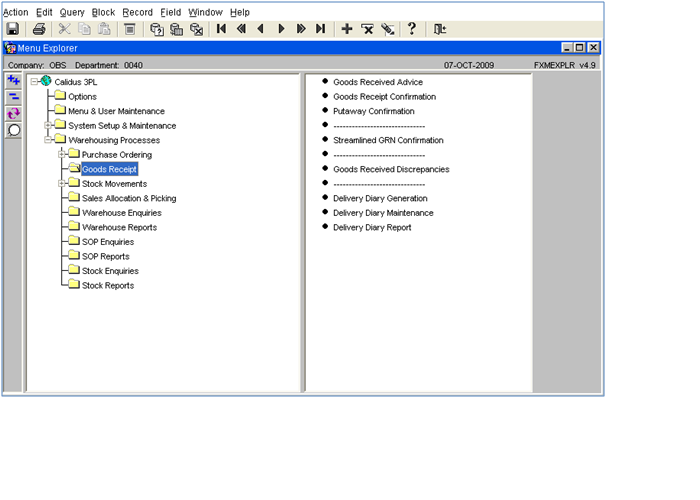
Function toolbar
The purpose of the function toolbar is to allow the user to query, insert, delete and update information. The main applications used are shown as icons on the formatting toolbar.
Each function has a list of associated functions attached to it, these can be can be accessed by clicking on them using the mouse or pressing the underlined letter on the keyboard.
- Action
- Save - saves changed data (see below for important information on saving)
- Clear All - clears all existing data
- Print - prints the screen
- Exit - exits the screen (however use the exit icon - see below)
- Edit
- Cut - cuts selected information to be moved elsewhere*
- Copy - makes a copy of selected information*
- Paste - pastes either the cut or copied information to the selected new location*
- Edit - find and replace function for text
- Display list - produces a list of values for the field that can be selected for the field
- Query
- Enter - used to find existing data using specific parameters
- Execute - asks the system to find data within selected parameters
- Cancel - cancels any query that was set up
- Last criteria - retrieves last query
- Count hits - displays quantity of records to search
- Fetch next set - retrieves next set of data
- Block
- Previous - moves cursor to previous block of data
- Next - moves cursor to next block of data
- Clear - clears information in the block of data the cursor is in
- Record
- Previous - displays previous record
- Next - displays next record
- Page up - moves scroll bar up
- Page down - moves scroll bar down
- First - displays first record
- Last - display last record
- Insert - clears data for new record to be inserted
- Remove - deletes data permanently
- Duplicate - duplicate previous record data in next record for updating purposes
- Clear - clear the record
- Field
- Previous - moves to previous field
- Next - moves to next field
- Clear - clears the selected field
- Duplicate - duplicates previous field data in next detail line
- Help
- Screen Help - prompts a help page for the screen
- Contents and Index - N/A
- Properties - displays the properties of the selected field
- Keys - lists the functions keys to use instead of a mouse
- Display error - display error details on the information bar
- Display common - displays common details about the user and system setting
- About fulfillmentSCE - web page
Format Toolbar
The formatting toolbar is made up of the most regular functions used in navigating through the system. Icon buttons are displayed for quick access, all the functions are as detailed in the previous section.
From left to right:
- Save
- Cut *
- Copy *
- Paste *
- List of Values (LOV)
- Enter a query
- Execute a query
- Cancel a query
- First record
- Previous page
- Previous record
- Next record
- Next page
- Last page
- Insert
- Remove
- Clear
- Help
- Exit
![]() Note: Items marked with an asterisk (*) are mainly used in Notepad screens.
Note: Items marked with an asterisk (*) are mainly used in Notepad screens.
TO SAVE CHANGES/AMENDMENTS
![]() Note: To ensure that any change to data input is saved, even to a single field, you must move out of the last field that you have changed before you exit the screen. If you do not then the system will not recognise the change, even if you hit save.
Note: To ensure that any change to data input is saved, even to a single field, you must move out of the last field that you have changed before you exit the screen. If you do not then the system will not recognise the change, even if you hit save.
You can move out of the last changed field by either using the enter key, the tab key or by using your mouse to click onto another field.
Title Bar
The purpose of the title bar is to tell the user the system parameters that they are working within.

The purpose of this toolbar is to help the user navigate through the menu tree options.
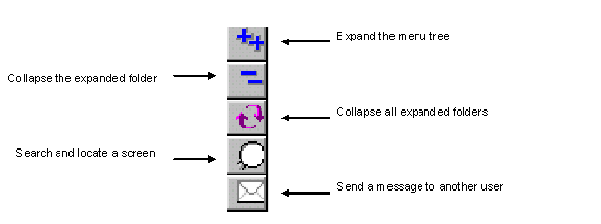
Screen Locator
The purpose of the screen locator is to find a screen if the user is unsure about where is it located in the menu tree.
When the user clicks on the locator button a screen appears which enables the user to enter either the screen number or the screen title. The system searches for the screen when the 'execute query' button is pressed and displays the screen details in the information bar underneath. When the user clicks on the detail line they are taken into the screen. It should be noted, however, that the Screen Locator tool will only 'find' screens that are included in the menu trees. It will not 'find' screens that are called from within another screen.

Messages
The purpose of the message icon is functionally the same as normal e-mail; the screen displays messages received and clicking on the details line or clicking the details button will open up the message. It is not an e-mail function. It will only send mail to other CALIDUS system users who are included in a valid e-mail list.
The filter is used to specify what the user wants to do;
- To compile a message, select new from the filter or click on the new button
- To read received mail, select received from the filter (a message is received when the message button is yellow instead of white).
- To view deleted messages, select deleted from the filter
- To check if a message has been read, select outgoing from the filter
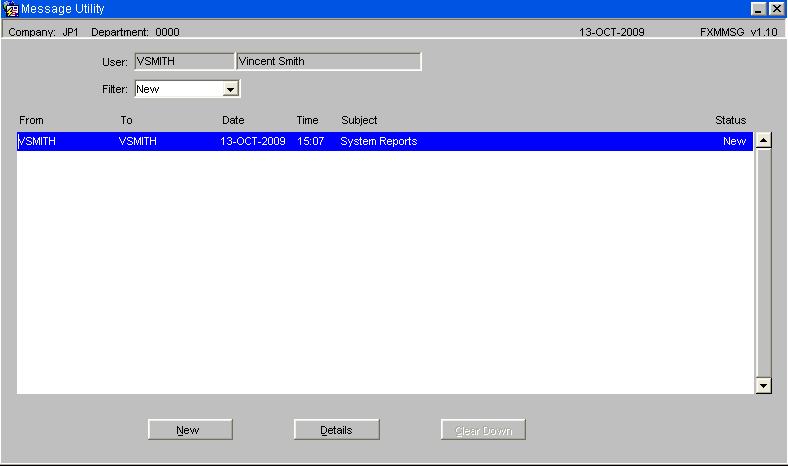
Tree Structures
The purpose of the main menu screen is to allow the user access to the required screen. The tree menu structure is designed to allow the user to access the screens logically and quickly. The meuns are configurable and can be customised as required. See Menu Maintenance for more details.
All information is stored in yellow file folders to the left of the screen, if the folder has a plus sign to the left of it, then there are more folders associated with it.
When the folder is selected the icon shows that it is open, all the screens associated with the folder header are detailed on the right of the screen and can be accessed by clicking on the screen title.
- Click on the plus sign or the yellow folder to expand the tree and show the associated folders.
- Click on the minus sign to collapse the tree back to the main folder.
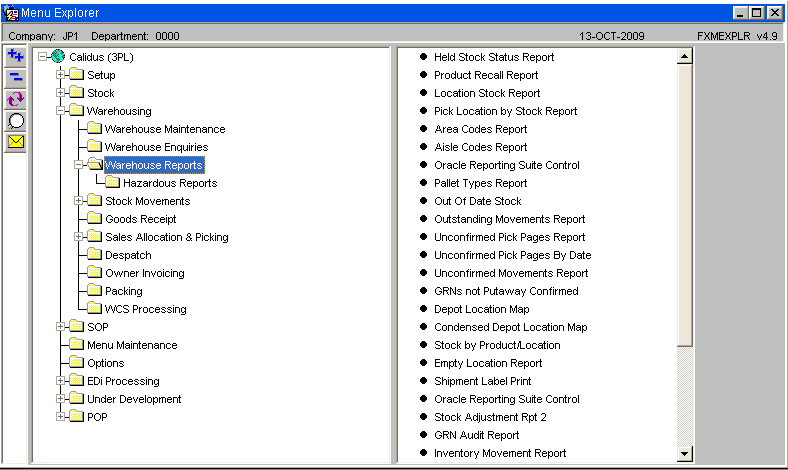
Information Bar
The purpose of the information bar is to provide details to the user of what the status of the screen is, i.e. executing a query, loading a new screen, or, what functions are available for the selected field.
Status of the screen
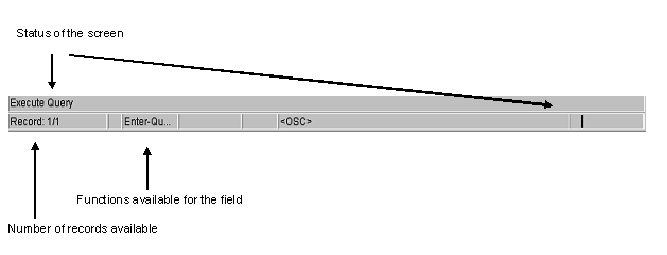
Querying Records
The purpose of querying records is to search, locate and display information quickly rather than paging through information.
To enter a query the user clicks on the 'enter query' button on the formatting toolbar. The user will know that they are in 'enter query' mode when the title bar changes colour and the information bar will have a query message displayed on it.
The user then enters the information they wish to query i.e. a booking reference and clicks on the 'execute query' button on the formatting toolbar, the system will then display the relevant record and the title bar and information bar will return back to normal.
The cancel query button will clear any query information that is on the screen to allow the user to enter new details.
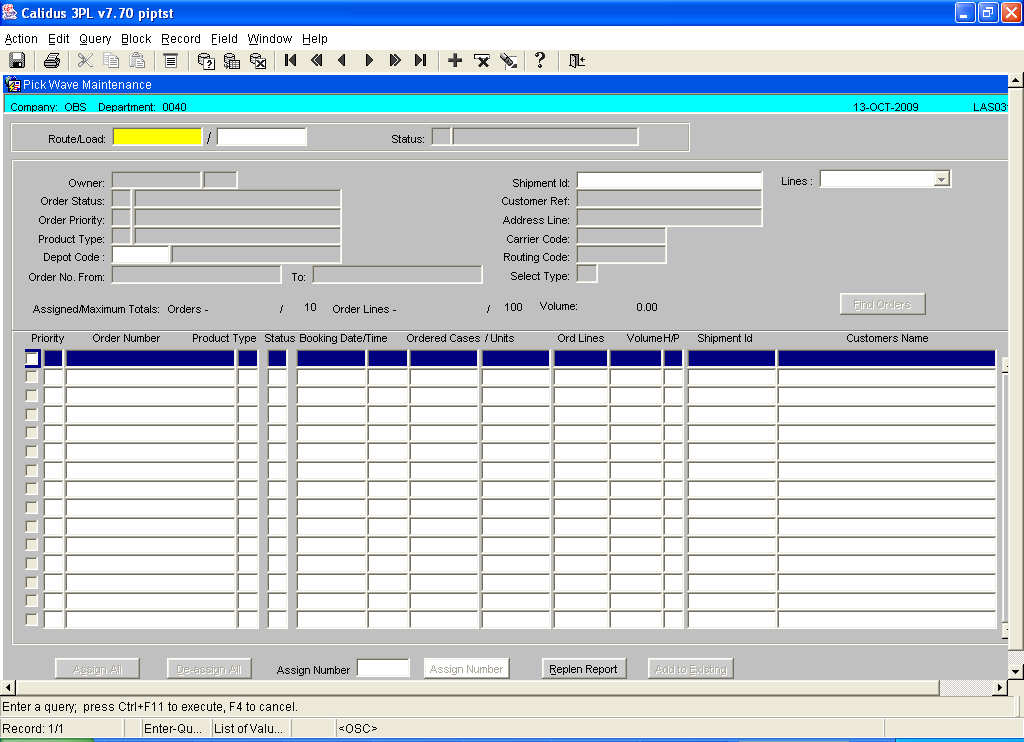
List of Values (LOV)
The purpose of a list of values is to provide the user with associated information attached to a specific field. The mandatory or main information fields will usually have a LOV attached to it. This is shown in the information bar at the bottom of the screen.
For example, Currency Code will have a LOV of existing Currency Codes
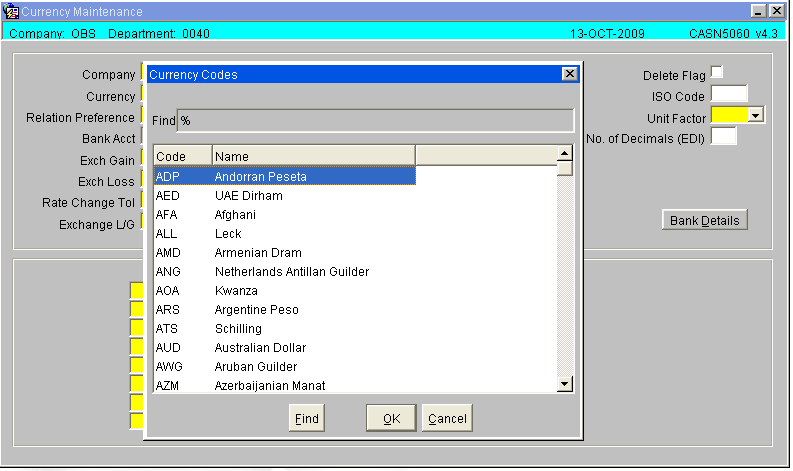
Partial LOV
The purpose of a partial LOV is to be specific about the data the user wishes to retrieve,
For example, a user wishes to enter a Customer code for WH SMITH
The user enters the first letter of the partner then clicks on the LOV icon on the formatting toolbar, this action pulls up the LOV for partners but is filtered straight to partners beginning with W. The user can select the required data from the list displayed by highlighting the detail line and clicking on the OK button.
The scroll bar on the right of the LOV allows the user to look throughout the list of information.
The find field at the top of the LOV can be entered into and more specific data can be added and filtered using the find button.
The percentage sign is a programming key that tells the system to find all information containing text within the parameters, this key can be entered either in the field before the LOV is displayed to go to specific information direct.
Screen Buttons
The purpose of screen buttons are to access additional relevant screens from the screen the user is currently working in. This saves the user from having to exit back to the main menu screen to enter more details.
For example, the Pick Confirmation screen has various buttons to help the user to enter direct information about the order, - Details, Order Notes etc
When a button is pressed the called screen is displayed on top of the existing screen. When exiting the called screen, the user will be returned to the calling screen.

Right Click Function
On certain screens it is possible to use a right mouse click (or the right click/list key on the keyboard) to call a panel of options. For example, on the Goods Receipt Confirmation screen (WHS01501), the right click function is used on the stock code line to call a panel of options.
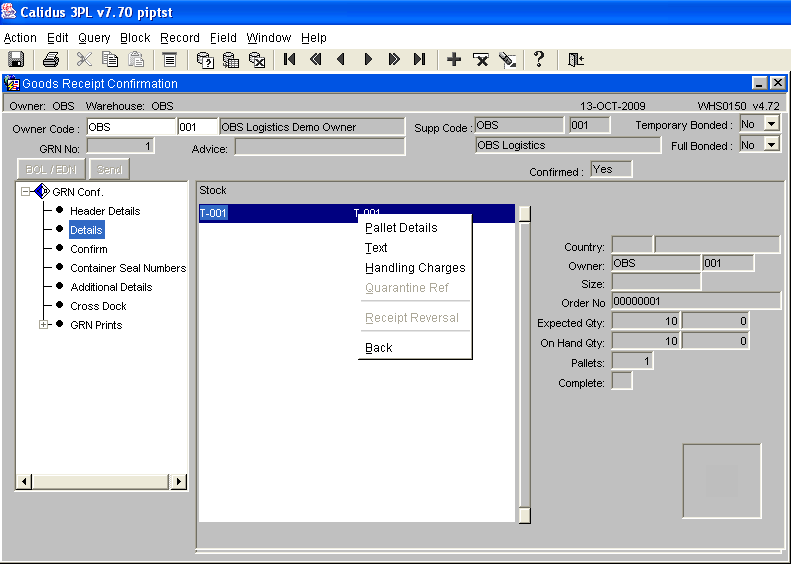
Document History
Copyright OBS Logistics © 2008
The information contained herein is the property of OBS Logistics and is supplied without liability for errors or omissions. No part may be reproduced or used except as authorised by contract or other written permission. The copyright and foregoing restriction on reproduction and use extend to all media in which the information may be embodied